
Original Link: https://www.anandtech.com/show/2546
Recently, we were in search of a new PC case to fulfill the role of arduous performance oriented motherboard review testing. We decided to step up from our trusty Lian Li PC75 to something more current. We have been looking for a something that is a little more friendly to the continual chopping and changing of vital system components that we subject our lab PC cases to at least a couple of times a week. Naturally, as previous Lian Li case owners we were drawn to their newer offerings, especially the revised V-Series that was unveiled at CeBIT in Hannover earlier this year. There, Lian Li publicized a few shake-ups to their entire consumer case line-up; notable additions to the vast lineup are gaming cases known as the Armorsuit series and new cases for the HTPC buffs among us.
For the V-series of cases, most of the revisions are centered on functionality rather than radical changes in aesthetics. The clean look that is synonymous with Lian Li remains intact. Internal graphics card holders, hard drive cages, and intake fans all receive a work over to ensure the ease of use of these components remains in line with the demands of today's user. The new V-series features standard ATX motherboard tray orientation while the "upside-down" ATX motherboard tray is still available in the V "Plus II" series of cases. At the top of the list to replace our aging and battle worn PC-75 is the PC-V2110 (ATX). It's a full tower case offering plenty of room for us to go wild without cutting ourselves or spitting out several new swear words every time we swap components.
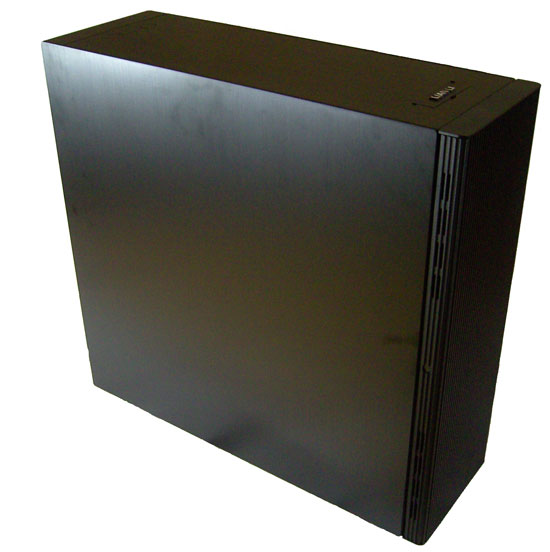 |
Lian Li is one of those companies that enjoys fierce user loyalty. It's a situation where if you've owned a case from them in the past, the first port of call for a new purchase is likely to be another case from Lian Li. Make no mistake, the PC-V2110 is an expensive case aimed at the connoisseur; we don't know if we qualify as real life connoisseurs of all things fine, but it's nice to delude ourselves that perhaps we are.
At this end of the spectrum, ease of use, construction quality, airflow, expansion potential, and overall aesthetics rule, not necessarily reflecting return per dollar of cost. If a case can do all of the above well while managing to still look good, we have ourselves a winner. We felt it only fair to put our thoughts down on paper today to reveal what we think is good and what could perhaps be improved.
With the initial pleasantries out of the way, let's move on to the nitty-gritty of specifications and features.
Specifications
| Lian-Li PC-V2110 Specifications | |
| Case Size | "Super Full Tower" |
| Dimensions | 210x620X620 (W, H, D) |
| Front Bezel Material | Aluminium |
| Color | Available in Black or Silver |
| Side Panels | Anodized (Brush Effect), Windowed Panel available upon request |
| Weight | 14KG |
| Body Material | Aluminium |
| 5.25" External Drive Bays | 7 external 5.25" bays |
| 3.5" Ineternal Bays | 8 Internal 3.5" bays |
| Expansion Slots | 8 Rear Exapnsion Slots |
| Motherboard Compatbility | E-ATX,ATX, M-ATX |
| Front Case Fan | 14cm Ball Bearing, Selectable speeds = 800, 980 and 1180 RPM |
| Rear Case Fan | 12cm Ball Bearing, Selectable speeds = 1020, 1240 and 1500 RPM |
| Top I/O Panel | USB2.0 x 4, IEEE1394x1, E-SATA x 1, AC97+HD Audio |
| . | |
Case Layout
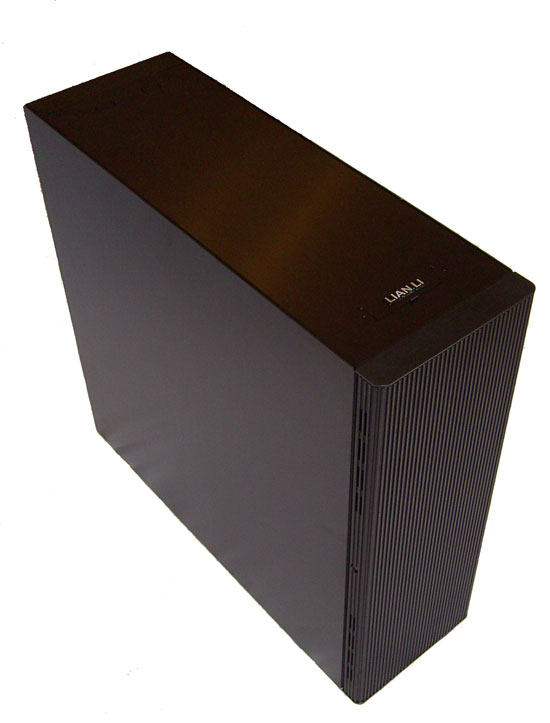 |
The chassis and panels are aluminum alloy, helping to keep weight to a minimum, and at a price point of ~$385 we'd expect no less. Aimed at those of us who prefer a minimalist look with straight lines, the PC-V2110 does not disappoint. The panel finish is brushed aluminum anodized in a choice of black or silver. A side effect of having the black finish is that finger prints show up like beacons from afar and will probably keep most of us reaching for a polishing cloth frequently, as we did through the course of testing the case. Unlike its PC-V2010 brethren, which offer a full-frontal look of the drive bays, the PC-V2110 keeps things hidden by means of a sturdy ridged front door. The door includes a lock and two keys for the security conscious.
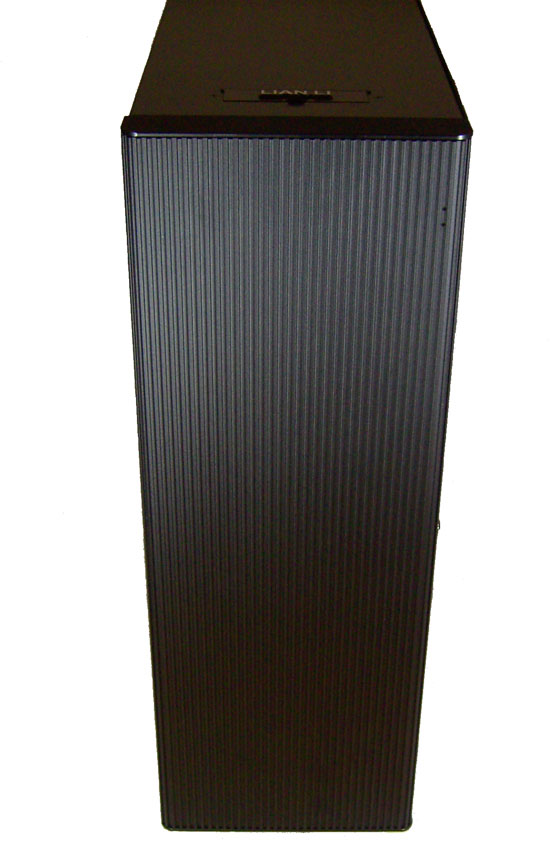 |
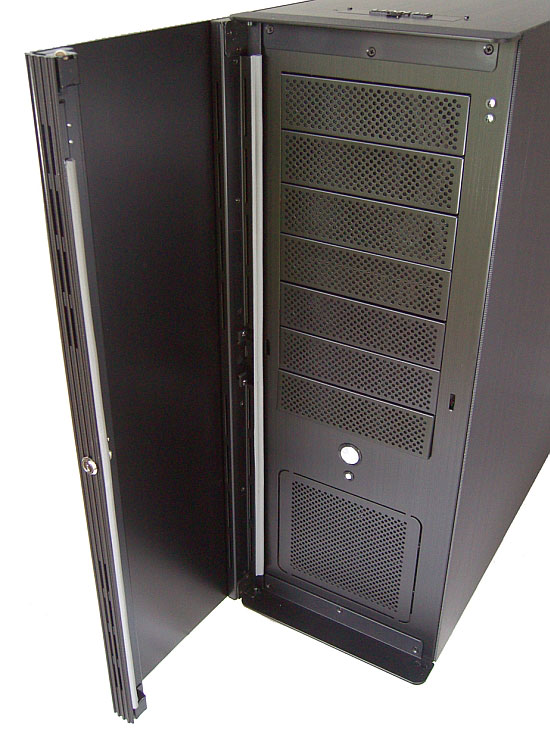 |
The door latches by means of ball bearings that slot securely into grooves in the top and bottom door brackets. Two rubber insulation strips on the door help to keep vibration and rattling to a minimum when fan speeds are ramped up. Users may also reverse the door mounting so that it opens from left to right if they wish, as the brackets are easily removed and reversed by means of six Phillips head screws. All front 5.25" bay panels are vented to allow for air intake, and they have small removable and washable nylon grills installed to prevent dust buildup within the case. The lowest square shaped grill in the picture is the inlet for the front 14cm fan.
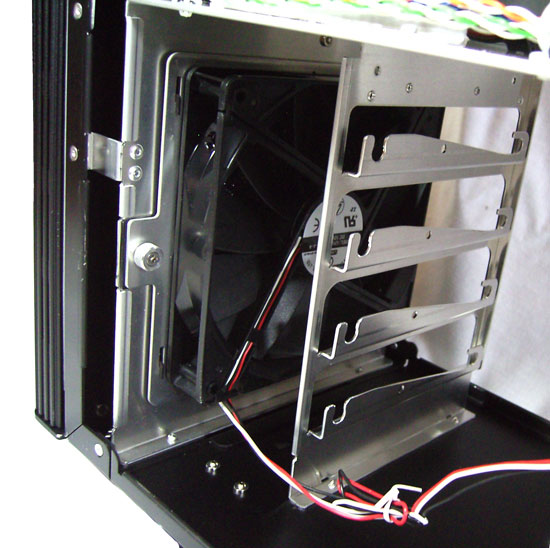 |
Both front and rear fans connect to a fan controller PCB located above the rear exhaust fan. An additional header is available for the supplied memory/chipset cooling fan and bracket. The front fan is easily removable for dust filter cleaning by means of two thumbscrews, though you will have to remove both side panels first. Removing the panels is quite easy as each panel features a single screw retention mechanism. However, we did find the lower door bracket on both panels has a very tight grip on the lip of the case; a smearing of Vaseline should help with removal if you plan to swap components frequently.
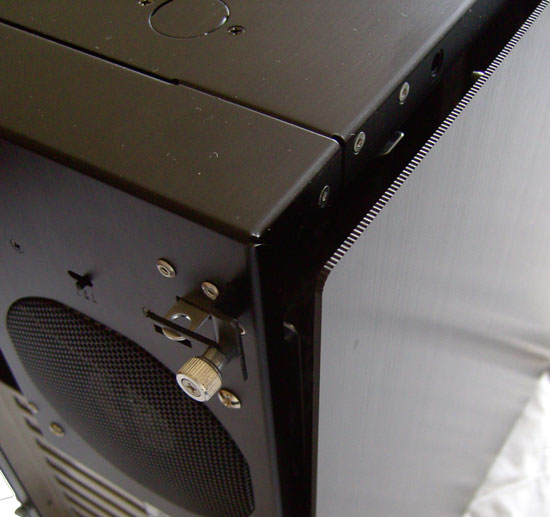 |
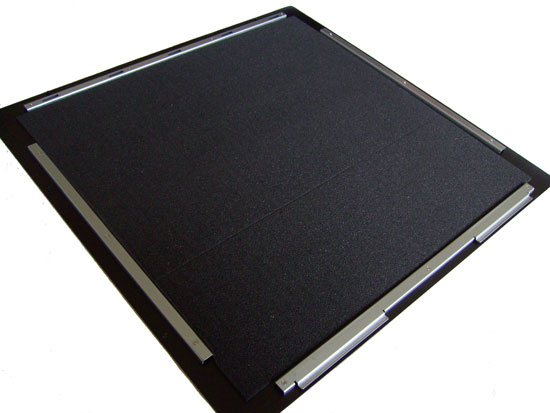 |
A significant portion of case weight comes from the side panels, which are thick aluminum with a brushed anodized finish. Sound deadening material has been applied to both panels and the top panel of the case, which should help reduce overall system noise. There are no elaborate or garish patterns on the side panels; instead, a decorative serrated edge on the panels complements the clean look of the case.
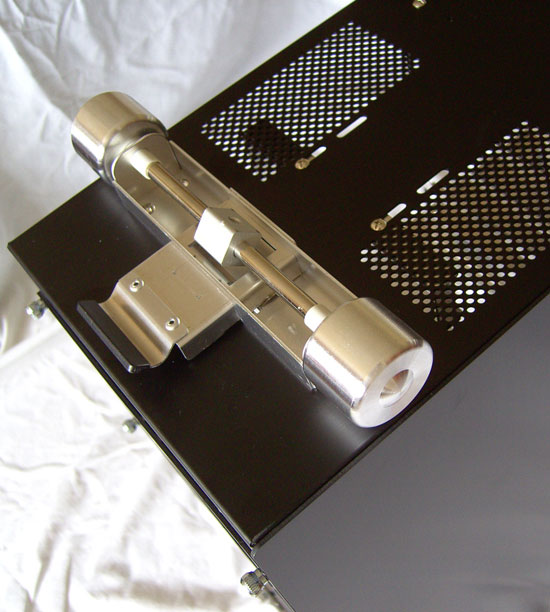 |
Silver castors add some mobility to the case and a touch of aesthetic class to the overall look. The castors do not swivel; rather a fixed position is used meaning movement is limited to forwards and backwards rolling (though you can slide the case to turn it a bit if necessary). The rear castors feature a brake mechanism so that the case does not roll freely once it's in the desired location.
Case Details and Layout, Cont'd
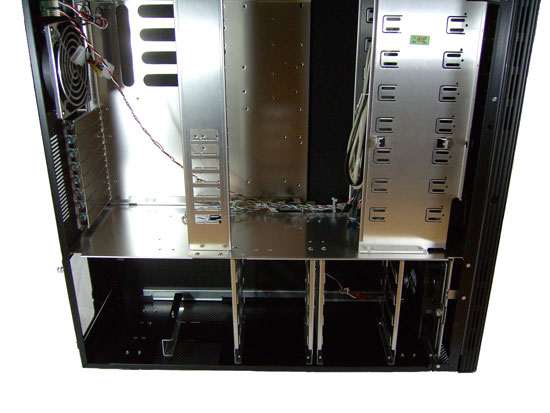 |
As usual for a top-end Lian Li case, the V2110 is divided up into two chambers, allowing for efficient cooling of the hard drives and protecting the upper chamber from additional heat. The top section is home to the seven 5.25" bays at the front of the case. We also found ample room to work with even if a full size E-ATX motherboard is used; around 3" of clearance is available past the end of the motherboard tray and the start of the front drive bays.
Although all of the 5.25" bay covers have grilles, there is no direct intake fan located in the top chamber; likewise, there isn't any additional airflow provided for dual GPU systems. Lian Li does offer add-on GPU bay coolers in various configurations should the need arise, albeit at extra cost. Users who will run ultra high-end GPU configurations and wish to use a Lian Li case will probably opt for the Armorsuit PC-P80 or upcoming TYR PC-X2000. Both cases offer superior motherboard chamber airflow by means of large 140mm intake fans at the front panel.
That's not to say the V-2110 has no added provision for multi-GPU configurations; a support bar that vertically spans the center of the motherboard chamber caters to those mounting larger cards. This bar includes small plastic connectors that clip onto the back end of the graphics cards to hold them firmly in position and prevent vertical movement once they are in the PCI-E slots. We feel an unmodified case will probably be comfortable enough with 8800 GTS cards in SLI, but will certainly struggle with bigger cards like the 3870X2 in Crossfire X. Also, note this is not a tool-less design, which may actually be a blessing as often the mechanisms used to eradicate the use of screws are more of a pain to use and/or less durable.
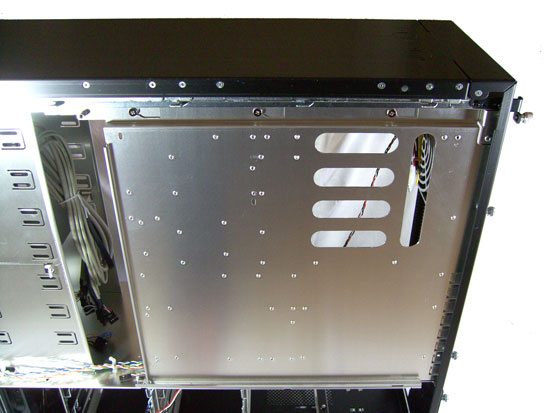 |
A removable motherboard tray is a must for a case of this class and we find the V-2110 has one that is easily removed by unscrewing two thumbscrews on the rear panel. Slotting the tray back into place is rather easy even when the tray is loaded with a large CPU cooler.
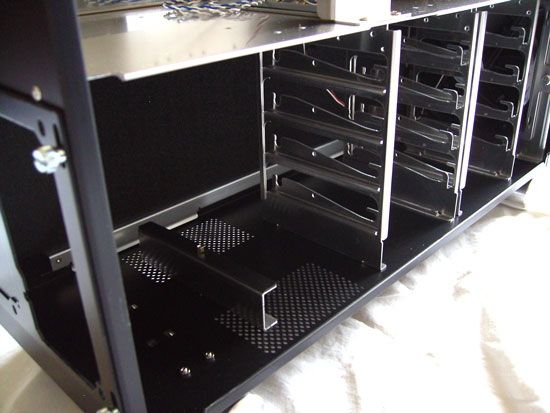 |
Hard drives are mounted with thumbscrews and rubber grommets and can be removed easily because the grommets merely "slide" into the cage rails rather than being bolted into place. The mounting mechanism is very secure, works very well, and keeps vibration transfer into the case structure to a minimum.
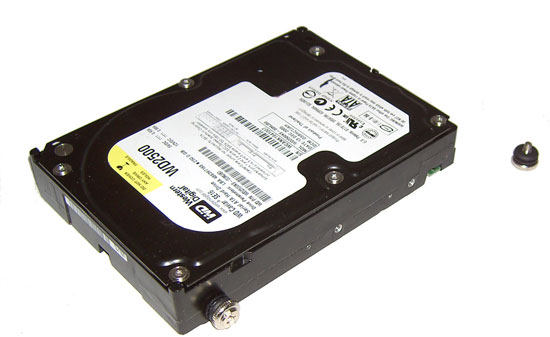 |
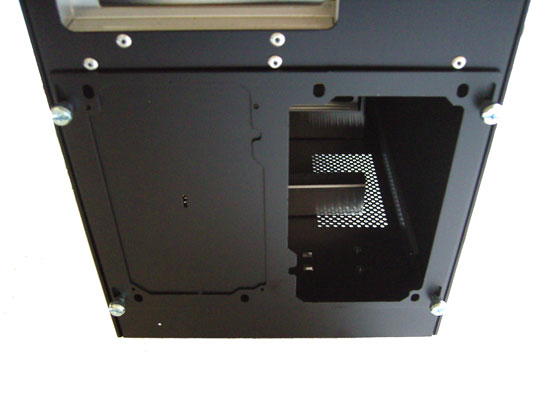 |
The PSU mounting bracket is reversible and can house two power supplies simultaneously if required. Vibration damping is offered by means of an additional mounting screw and grommet, which bolts through the panel that separates the upper and lower chambers to push against the PSU housing. Note that the case layout means the 24-pin ATX and ATX/EPS 12V cables will need to be around 19" long to reach most motherboard connectors without the need for an extension cable.
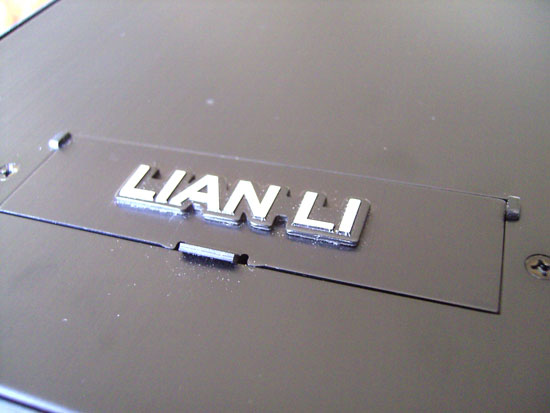 |
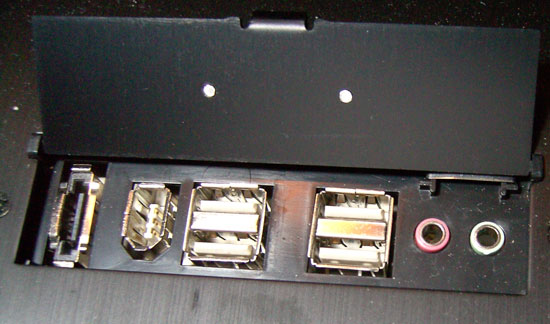 |
Moving on to the top panel, a flap bearing the Lian Li logo can be flipped back to reveal the front connectors for audio, 4 USB ports, a 1394 port, and an eSATA connector. Internal cables are more than long enough to reach all motherboards if going the direct route, though they are not long enough to hide around the back of panels in all situations.
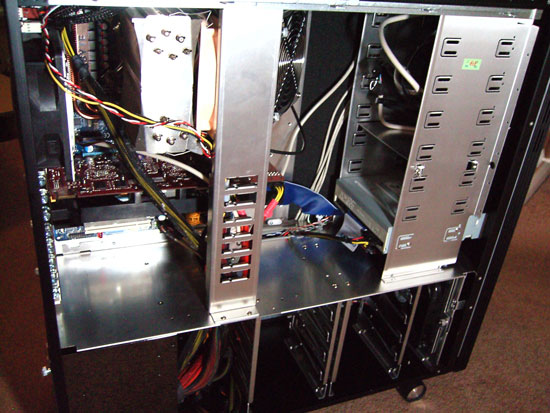 |
Temperature Testing
| Lian-LI PC-V2110 Build Components | |
| Motherboard | Gigabyte X48 DQ6 |
| CPU | Intel QX9650 Quad Core Processor 12MB cache |
| GPU | ASUS 3870X2 4XDVI version |
| PSU | OCZ Pro X Stream 1000w |
| Cooling | Thermalright Ultra 120MM + Noctua NF-P12 120mm Fan |
| Memory | 4GB OCZ Flex II 9200 |
| Hard Drive | Western Digital Caviar 250GB 16MB Cache |
| DVD | Plextor 755A |
| . | |
We encountered no problems installing all of our components. Mounting the Thermalright Ultra-120 prior to installing the motherboard tray in the case was not an issue, and as you can see from the picture there is just enough clearance to allow mounting the fan on the CPU cooler on either side of the heatsink. Testing revealed that using the fan in push configuration was best as we found that the back top corner of the case becomes a heat trap if the fan on the CPU cooler is mounted in a pull configuration. We managed to tuck a few of the cables around the back of the front drive bays to keep things a little cleaner and to prevent airflow restriction to a small extent.
The next step was to fire up the system and check temperature deltas between idle and load during gaming and heavy processor loading. Initial tests were all run with a stock configuration using the 3-speed fan controller on each setting and monitoring for change after 30 minutes of system loading. The stock cooling configuration is fairly quiet at around a 1m distance; the sound of the fans at high is not overly disturbing. Most of the noise we experienced came from the annoying 80mm fan of the OCZ 1000w PSU. We used Prime95's torture test for 30 minutes along with 30 minutes of Codemasters excellent GRiD Racing to simulate a typical gaming session and monitored load temperatures using a combination of Everest and Riva Tuner.

Using the stock exhaust fan, a setting of low is just about able to hold a QX9650 and 3870X2 card at acceptable temps in a 16C ambient room. Higher ambient temperatures or rooms with less airflow may wish to opt for medium to high settings to keep temperatures at acceptable levels for long load durations. For a QX9650 at 4GHz with a processor core voltage of 1.34V, using a fan setting of high really is the only option. Even with the fans all set to high the back corner of the top panel does get quite hot during extended gaming sessions when using ASUS's 4XDVI 3870X2 card - mainly because the custom cooler on ASUS' card dumps all of its heat into the case.
We also tested with a Panaflo 120x38mm fan on high during gaming and monitored temperatures. We were surprised to find a 6-10C improvement in temperatures at the expense of added noise. Mind you, the fan speed controller really does come in handy as the fan can be set to low during light system load with no perceived increase in volume over the stock Lian Li offering.
Conclusion
Our time with the PC-V2110 has certainly been pleasurable to this point; we have no major gripes with the case and think it will fill the role demanded from it admirably. However, we do feel that Lian Li should bundle a cross flow fan for the graphics card area of the case, which will increase its appeal to multi-GPU system builders. A more powerful stock exhaust fan also would have been nice, though we accept that Lian Li had quiet operation in mind.
Using the case's stock air-cooling you'll find quad-core processors with a single graphics card solution have just enough leeway for a moderate to high overclock and comfortable temperatures. For those looking to water-cool, the PC-V2110 has ample room in its lower chamber for modification and use of the acclaimed Thermochill PA 120.3 radiators, which will involve the removal or hacking of the hard drive cages. Alternately, if you can't handle taking a jigsaw to a $385 case, a rear-mounted external radiator may be used with tubing fed in through the holes in the top panel of the case.
There is certainly competition in this price class. A few models from Lian Li offer variations in certain departments, mainly airflow related changes appealing to particular usage scenarios like the PC-P80 for gaming enthusiasts. Silverstone cases are also no slouch in this department or price class with cases such as the mighty TJ-07 on offer with pleasing aesthetics and optimized airflow for overclocking enthusiasts, and Gary still swears by his Cooler Master Stacker cases.
There's no doubt that users who see a case as a necessity rather than a stylish addition to their living space won't find the price of the PC-V2110 attractive. Especially as some of the perceived advantages of owning a top-end-top-price case have begun to filter into lower price bracket offerings - ergo all aluminum construction, quick release side panel mechanisms, removable motherboard trays, and independent hard drive and PSU chambers are becoming more common additions to cases at midrange price points (upwards of $150).
For those that demand ultimate quality and class, the PC-V2110 qualifies as the stylish statesman of PC cases. It's ready to accept a hefty processor and high-end graphics card out of the box with no difficulty. If you're willing to add a few more extra fans, it can hold pretty much all the computer you want to throw at it. If you have the money to burn and find yourself partial to Lian Li quality and styling, you won't be disappointed with the V2110.







